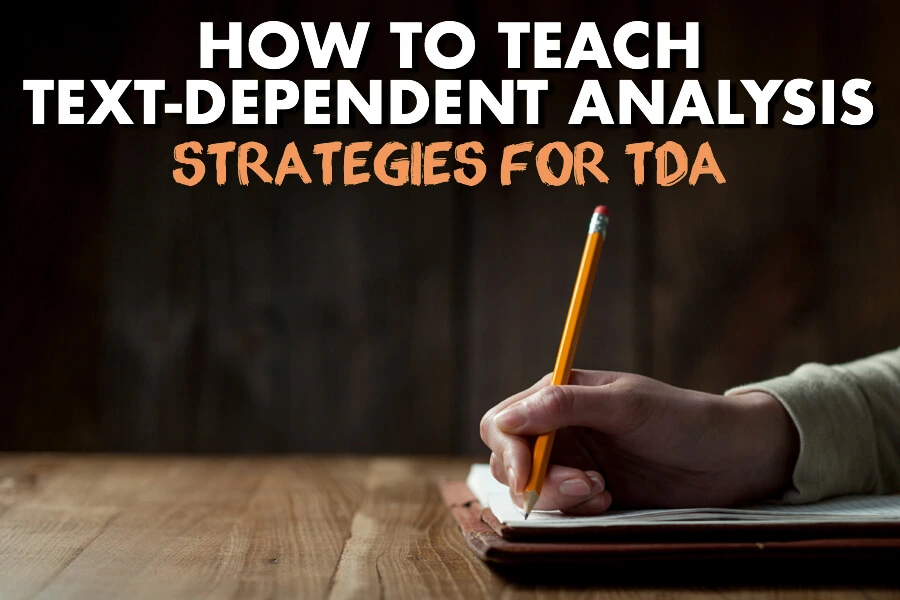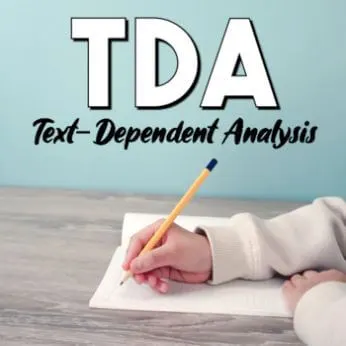A TDA — or text-dependent analysis — is a common writing assessment administered by teachers and featured on state and national standardized tests. TDAs are administered to gauge a student’s ability to effectively complete a variety of writing tasks at a specific learning stage and within a given time period (usually around one hour).
Typically, a teacher will start by reading a question or statement that prompts the student to synthesize a response based on evidence within the text. Students use a variety of strategies to complete a TDA, including close reading, annotating, outlining, and revising based on feedback.
For many middle and high school students, the TDA is an introduction to lengthier writing assignments that require higher reading stamina, comprehension, and critical thinking skills to complete. Below, I’ve listed a few strategies for teachers to guide their students through the text-dependent analysis assignment and help them improve as writers.
It starts with a question — create specific prompts from relevant texts
From the start, instructor-designed questions should prompt students to synthesize their response based on evidence from the text. A TDA is analytical, not argumentative, and educators should emphasize the importance of interpreting the author’s intent behind a word, phrase, or writing choice, as opposed to sharing their personal opinions.
Teachers should ideally craft prompts that encourage student writers to do the following:
- Go back to the text to search for evidence
- Use appropriate evidence from the text to support their claims or ideas
- Make connections between textual evidence and the real world or other texts
- Form original or interesting insights
If a student can answer the question without engaging in any of the above bulleted thinking tasks, the TDA prompt is not an effective one.
TDA prompts are typically less than a paragraph. When crafting a prompt, aim for conciseness and specificity. Introduce the question or piece of text under consideration. Use strong action verbs — such as justify, interpret, evaluate, and compare — to communicate what it is you want a student to do in their response.
Often, a TDA may focus on a particular line or phrase. Instructors may find the backwards design process useful in creating strong TDA prompts. First, identify key points that students might glean from your selected text — many prompts focus on a particular theme, motif, or symbol that recurs throughout the passage. Then, ask what learning you want students to demonstrate — have you been working on drafting smooth transitions? Studying rhetorical choices in argumentative writing?
Studying how a character’s point of view affects the overall meaning of a text? Your selected text should model the skill or standard that students are attempting to master. Finally, do your best to read your prompt through the lens of your students. Does the prompt make sense? Can they complete what you’re asking them to do within the given time frame? Is the prompt interesting? Students will more likely enjoy writing about what interests them versus content that they don’t connect with or understand.
Build the essay one piece at a time — model with low stakes assignments
A sufficient TDA response is usually 2+ single-spaced pages and composed of three parts:
- A brief introduction
- Well-developed body paragraphs
- A concise conclusion
Within their given time range, students naturally spend the most time composing their body paragraphs; this is also the area where they typically experience the most challenges (particularly with more difficult reading passages). Depending on the grade and skill level of the students, it may be helpful to scaffold by modeling the TDA process with shorter reading passages. To make the writing process more approachable for novice writers, I suggest using a document camera and the 3 C’s approach to model effective analytical writing.
In the 3 C’s approach, students start a paragraph with the context, transition to relevant content, and expound by making a connection.
The context is a short, 1-2 sentence introduction to orient the reader to the part of the text that the reader is about to discuss. For example, if the TDA prompt asks students to identify why John Steinbeck uses personification to characterize Lenny in Of Mice and Men, the student writer might begin with the following context: “When the reader first encounters George and Lenny in the forest, Steinbeck compares Lenny’s behavior to a horse.”
After the writer quickly ‘transports’ the reader to the context of the story, they will next write their content, which is another term for textual evidence. Students can paraphrase or add direct quotations — regardless, they should make sure the content is integrated and avoid ‘quote-bombing’ an analytical paragraph. A quote-bomb is a writing error in which a writer includes a quote without any context or transition. It feels abrupt to a reader and may cause confusion. There are a variety of sentence stems that teachers can model to help students transition from one point to another. Teachers may find it helpful to create a one-page list of sentence starters that are useful for transitions within and between paragraphs.
The final C — or connection — is the most important part of the analytical paragraph, and should therefore be the most substantial. In the connection, the writer shares their interpretation of the textual evidence. Model possible text-to-self, text-to-text, and text-to-world connections and have students choose which one makes the strongest point. After integrating a quote from Of Mice and Men that compares Lenny to a horse drinking water, the student writer might make a connection to a real-world context, like historical mental institutions, in which disabled persons were treated like animals and forced to live in inhumane conditions, or another character from a different book/film who shared similar behaviors and thought patterns with Lenny.
Your time starts now — begin with a plan
After sufficient practice with shorter analytical paragraphs, students will be ready to take on the TDA. Perhaps the most important strategy for teachers to model occurs before the student even picks up the pen to write their introductory paragraph. Educators should encourage students to use the first 5-10 minutes of a timed TDA to come up with a plan, following these steps:
- Read and annotate the prompt — be clear on what it is actually asking you to do. Many students scan the prompt and receive lower grades on TDAs because their responses, while well-written, do not necessarily answer the prompt or question.
- Time it out — consider how much time you have to write the response and time out how long you will spend on each section of the TDA. For example, if the TDA is 60 minutes, a student might elect to spend:
- 00-05 Planning and outlining
- 05-15 Reading and annotating
- 15-50 Drafting
- 50-60 Proofreading and revising
Students should be very familiar with annotating a text prior to commencing a TDA; they may benefit from an annotation symbol key to keep the annotation process quick and efficient during their timed assessment. Model strategies such as underlining possible pieces of textual evidence to use, or jotting out ideas in the margins for text-to-world connections. Remind students that it is okay if their planning process is messy. Writing is messy. We don’t come up with the right words in the right order the first time. Establishing an annotation system that works for them can help students synthesize information and complete their TDAs more efficiently.
End with the beginning — draft an effective introduction and conclusion
While students should spend the least amount of time drafting the beginning and end of their TDA, these sections can sometimes be the most tricky to write. Writers often struggle with what to say and how to say it.
The introduction houses the thesis statement, or central point that they will make in the analytical body paragraphs that follow. Many teachers find that students are redundant or overly wordy in these sections. For the introduction, model the three essential parts: hook, background, thesis. The hook should entice a reader to keep reading your piece. The thesis is the most important sentence in a TDA — it should be clear regarding the writer’s point and serve as a roadmap for where the remainder of the essay will take the reader. The background merely ties the hook to the thesis in an insightful, logical, or illuminating way.
Conclusions should avoid repeating what has already been said verbatim; however, writers should also avoid raising new considerations in the conclusion. So how to end on a good note? Consider nudging the writer to synthesize or focus on one of the text-based connections they made in their body paragraphs, and return to comment on that insight.
Make a nod to something that the author implied or stated in the text. Perhaps there is a lesson to be found for future readers that the student feels is valuable or significant. The teacher can model these different strategies for the same paragraph and show students how writing is so much more than pen to paper, but a series of big and small organizational and linguistic decisions that hopefully, when combined, will not only make sense to a reader, but compel them to think more deeply about an issue or problem in society.
Some teachers might find it useful to encourage students to tackle the introduction and conclusion after drafting their body paragraphs, since the body is where they will demonstrate most of their writing skills. It depends on the reader — encourage them to allot a short amount of time to the introduction and conclusion where it makes sense to do so in their writing process.
Delay the grade — encourage students to read and apply feedback
Time’s up! After a timed TDA, the teacher is likely to collect essays demonstrating a range of efforts and abilities. Some students may have resonated with the prompt and written several pages of content. Others may not have completed the assessment in full. Regardless of completion, educators should focus their feedback on what was provided (and not what wasn’t).
Students are motivated by grades for many reasons. Many educators also find that students do not take the time to read and apply feedback after they have already received a grade. For this reason, we encourage ‘delaying the grade’; meaning, provide detailed feedback for the student to digest and apply before you input a final grade. This practice conveys to students that (1) you, as a teacher, genuinely care about their improvement, and (2) you will base their next TDA grade partly on how well they applied their feedback from the previous one. By delaying the grade, you may find that students are more incentivized to correct their mistakes and invest in improving as writers.
The TDA can be used as a powerful instructional tool for just about any content area. By devising interesting and relevant prompts, teachers can prompt students to think deeply about a range of important issues. Brainstorming and creating an outline is applicable to so many content areas and real-world contexts. Modeling how to break down a task can reduce the anxiety that often accompanies more intimidating writing forms like the TDA and help a student make decisions that improve their efficiency. Using low stakes assignments to practice integrating context, content, and connection can build a student’s confidence up before they take on the lengthier TDA. The key to student improvement is receiving and applying constructive feedback.


